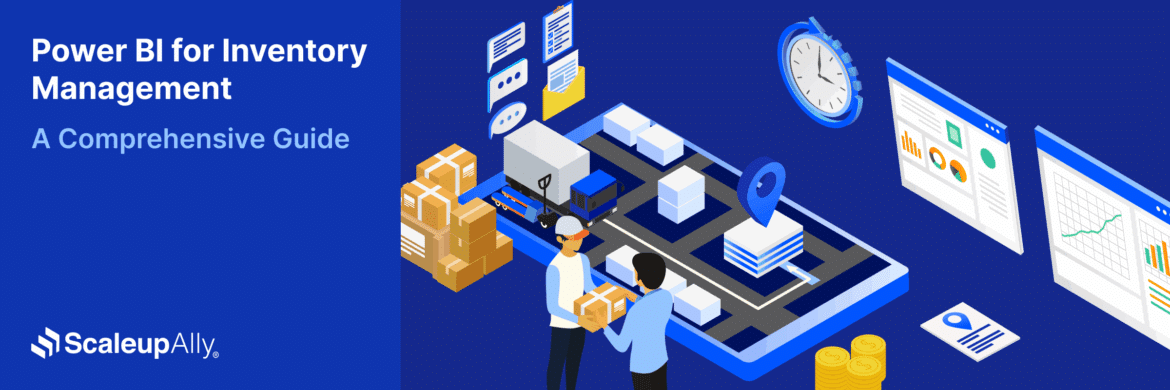
Agile Business Analysis: Methodologies and Best Practices
ScaleupAlly Team | November 29, 2024 , 8 min read
Table Of Content
Agility is a cornerstone for success in today’s fast-moving business environment. Businesses now need to adapt to changing consumer demands and intense competition in addition to technological advancements.
Agile business analysis is an essential instrument to overcome the associated problems and enable businesses to stay agile and dedicated to uninterrupted value output. Agile business analysis is a continuous process rather than an event like other traditional analysis methods.
It’s rather seamless integration with Agile approaches allows teams to define, improve, and deliver business requirements iteratively. This blog investigates the ideas, methods, and resources that make Agile Business Analysis revolutionary in today’s corporate settings.
What is Agile Business Analysis?
- What is Agile Business Analysis?
- Why is Agile Business Analysis Important?
- Key Principles of Agile Business Analysis
- The Application of Agile Business Analysis
- Key Activities in Agile Business Analysis
- Tools and Techniques in Agile Business Analysis
- Best Practices for Agile Business Analysis
- Overcoming Challenges in Agile Business Analysis
- How Agile Business Analysis Differs from Traditional Analysis?
- The Future of Agile Business Analysis
- Conclusion
- Frequently Asked Questions
Agile business analysis is another term that describes the practice of doing analysis tasks based on the principles of Agile. This approach addresses the acceptance of change, intense collaboration with stakeholders, and gradual provision of value.
In traditional models of analysis, most of the work is done upfront, often resulting in rigid plans that are difficult to adjust to changing requirements. Agitate environments are better suited to Agile Business Analysis.
It articulates the continuous interaction with the stakeholders, improvement of requirements, and validation of solution designs through continuous feedback loops.
Why is Agile Business Analysis Important?
- Flexibility: Agile business analysis provides flexibility to teams to adapt to shifting priorities without the project turning into a mess.
- Stakeholder Alignment: Continuous collaboration ensures that the requirements of stakeholders are identified and addressed regularly.
- Faster Time-to-Market: Teams can deliver critical features sooner with incremental delivery, thus reaping business benefits sooner.
Key Principles of Agile Business Analysis
Several key concepts support agile business analysis, which distinguishes it from more traditional approaches:
1. Constantly Providing Value
Agile business analysis’s goal is to provide the business and end users with measurable value. By breaking up work into smaller, more manageable components, teams can focus on achieving tiny, controllable progress rather than waiting for a big release at the end.
2. Embracing Change
Since change is unavoidable, agile business analysis views it as an opportunity rather than a problem. As new data becomes available, analysts collaborate extensively with stakeholders to improve and rearrange requirements.
3. Cooperation Rather Than Isolation
Collaboration is required in Agile Business Analysis. To achieve alignment and shared ownership of results, teams across departments collaborate, such as product management, development, QA, and stakeholders.
4. An incremental and iterative approach
Agile business analysis ensures that the team can adapt in real-time to feedback by delivering work in small, manageable increments. This reduces the risk of building the wrong product and enhances quality overall.
The Application of Agile Business Analysis
Agile business analysis can be applied to several Agile approaches, such as Scrum, Kanban, and SAFe, and is not limited to any one framework. This is incorporated into a few widely known frameworks as follows:
1. Scrum
Agile Business Analysis in Scrum focuses on maintaining and enhancing the product backlog. Product owners and analysts work together to ensure user stories are well-defined, prioritized, and ready for sprints.
2. Kanban
The objective of Kanban is workflow management and visualization of work. Agile business analysis emphasizes the identification of bottlenecks, prioritization, and smoothing out work through the pipeline.
3. SAFe (Scaled Agile Framework)
SAFe provides a framework for Agile scaled at the business level. For accomplishing alignment assurance, analysts play an integral role in defining epics and features, breaking them down into user stories, and providing collaboration with teams of various disciplines.
Key Activities in Agile Business Analysis
There are many activities associated with agile business analysis. All of them are aimed at bringing teams into harmony with corporate goals. Some of these key activities are:
1. Backlog Refinement
The product backlog is an essential element in Agile business analysis. Analysts ensure that the items in the backlog are defined, prioritized, and ready for release. The way to achieve this is by breaking up more complex requirements, known as epics, into smaller chunks of user stories.
2. Stakeholder Engagement
Operational cooperation is necessary to understand the needs of stakeholders, which continuously shift. Analysts lead brainstorming, workshops, and interviews to elicit and validate requirements.
3. Documentation
Extensive documentation is minimized but not altogether avoided by Agile. To ensure clarity without losing agility, Agile Business Analysis uses elementary tools such as wireframes, acceptance criteria, and user stories.
4. Validating Deliverables
If business analysis is agile, consistent validation is a feature.
Analysts work with the stakeholders and end users to ensure that the increments produced meet the expected standards or provide actual value.
Tools and Techniques in Agile Business Analysis
Agile business analysis uses a variety of tools and techniques to prioritize work, encourage collaboration, and track progress. The most used tools within this category are:
1. User Stories
A user story is a relatively simple yet very effective means of writing down requirements. They keep the team focused on delivering value by concentrating on the “who,” “what,” and “why” of a requirement.
2. Acceptance Criteria
Acceptance criteria are clear about when a user story is done. This way, developers and stakeholders are both clear on what success looks like.
3. Story Mapping
Story mapping is a visually oriented approach to rank features, based upon their value to the user journey. It helps teams prioritize delivery around the most valuable features.
4. Backlog Management Tools
Other important tools include Jira, Trello, and Azure DevOps, which form a critical backbone for tracking progress, managing the backlog, and fostering teamwork.
Best Practices for Agile Business Analysis
Teams must embrace best practices that are in line with Agile principles if they are to succeed in Agile business analysis. Here are some important suggestions:
1. Focus on Business Outcomes
Agile business analysis is meant to deliver measurable business results, not just features. Analysts must ensure every action directly contributes quantifiable value and aligns with strategic objectives.
2. Engage Stakeholders Proactively
Stakeholder engagement is a precursor to success. In the execution of the project, analysts should work closely with stakeholders in managing their expectations, soliciting their views, and bringing out requirements.
3. Balance Documentation and Agility
Agile just does not reduce but also does not dispense with documentation completely. Analysts need to find a middle course between producing succinct artifacts that improve clarity and do not impede agility.
4. Use Feedback to Drive Improvements
Each iteration allows collecting input and making changes. Agile business analysis creates the opportunity for continuous learning and improvement while ensuring that feedback loops are introduced into the process.
Overcoming Challenges in Agile Business Analysis
Agile business analysis is not without its challenges. Some of the common challenges include:
1. Managing Uncertainty
Requirements in Agile frequently change over time. Analysts should accept this uncertainty and focus on delivering value incrementally.
2. Aligning Teams and Stakeholders
It is difficult to keep people aligned. Agile business analysis relies heavily on efficient communication and teamwork to overcome this barrier.
3. Balancing Speed and Quality
Because Agile is iterative, teams must produce work fast without sacrificing quality. In order to establish precise acceptance criteria and guarantee that quality standards are fulfilled, analysts are essential.
How Agile Business Analysis Differs from Traditional Analysis?
| Aspect | Traditional Analysis | Agile Business Analysis |
|---|---|---|
| Documentation | Extensive and static | Lightweight and iterative |
| Approach to Change | Resistant | Embraces change |
| Delivery | Big bang at the end | Incremental and iterative |
| Stakeholder Involvement | Limited | Continuous |
| Feedback Loops | Infrequent | Frequent |
The Future of Agile Business Analysis
Agile business analysis is evolving rapidly given the growing trend of automation, data-driven decision-making, and digital transformation.
As a result, analysts increasingly rely on sophisticated tools, including analytics and artificial intelligence, to boost their effectiveness. Business analytics will play a more prominent role in agile business analysis as companies continue to pursue agility for the success of the organization.
Conclusion
Agile business analysis is a mindset that inspires companies to add value in a world that continues to change rapidly, not just a technique.
Agile business analysis enables teams to be aligned with the business’s business outcomes and more responsive to change through embracing collaboration, iterative delivery, and continuous improvement.
Businesses that make investments in Agile Business Analysis will be positioned well to thrive in an increasingly competitive and dynamic market.
If you are looking for any business intelligence tools to be integrated, or agile custom software applications to be made, we (ScaleupAlly) are happy to help. Reach to us for a free consultation today.
Frequently Asked Questions
Q: What is business analysis in Agile?
By establishing user-centric requirements, encouraging feedback, and continuously improving features to guarantee they provide business value consistent with Agile principles, business analysis in Agile supports incremental and iterative development.
Q: What are the key principles of Agile business analysis?
Agile business analysis emphasizes teamwork, flexibility, value delivery, and ongoing development. It places a strong emphasis on dynamic requirements gathering, active stakeholder engagement, and setting priorities for features that optimize customer value.
Q: What is the difference between traditional and Agile business analysis?
Agile business analysis is flexible and collaborative, with a strong emphasis on iterative development, flexible requirements, and quick feedback loops. Traditional business analysis frequently takes a linear, documentation-heavy approach.
Q: What are the benefits of adopting an Agile BA mindset?
Flexibility, teamwork, and a value-centred approach are all encouraged by an Agile BA mindset. Business analysts with this mentality are better equipped to interact with stakeholders, adjust swiftly to changes and make sure that projects closely match client demands and corporate objectives.
Author Spotlight
Umesh Joshi, Project Manager II
Related Blogs

Data Warehouse Cost Breakdown: Factors, Pricing Models & Platform Comparison
Discover how much a data warehouse costs in 2025. Explore pricing models, key factors, and platform comparisons to plan your data budget effectively.
Tarsem Singh
Nov 6 ,
14 min read

How Much Do Integrations Cost? [Pricing Breakdown & Key Insights]
Learn how much integrations cost, key factors influencing pricing, hidden expenses to avoid, and effective ways to reduce integration costs.
Tarsem Singh
Nov 6 ,
9 min read

Power BI for Inventory Management: A Comprehensive Guide
Explore the hidden power of Power BI for inventory management and how it provides businesses with powerful analytics and visualization capabilities.
Tarsem Singh
Oct 8 ,
19 min read


